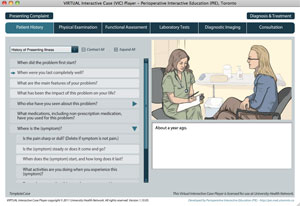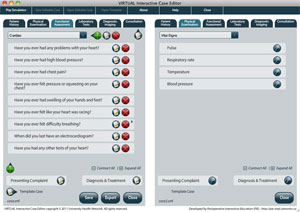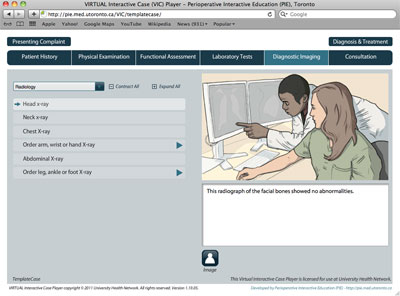Virtual Interactive Case System
Rationale for Virtual Patients:
Teaching clinical expertise and the cognitive processes involved in clinical reasoning that physicians use to arrive at a diagnosis has been a challenge since medicine began to be taught as a discipline. There seems to be a growing consensus that at least one important aspect of diagnostic acumen is pattern recognition. The development of pattern recognition requires exposure to a large number of cases. However, there are increasingly limited opportunities for students to get this exposure, and the experience they get is restricted to what happens to turn up in their clinical rotations.
Supplementing these clinical experiences with simulated clinical cases, or “virtual patients” provides the opportunity for exposing students to a wider variety and a greater number of cases than they would otherwise encounter. Virtual patients can also demonstrate different ways that the same disease can be manifested, and even deliberately creating the conditions that often result in diagnostic error. Feedback on the student’s performance provided by the program will improve their skill in applying their knowledge to the solution of diagnostic problems.
Virtual Interactive Case System
We have developed a tool, the Virtual Interactive Case (VIC) System, for creating virtual patients using Adobe Flash. Our tool allows users to develop cases on their personal computers, then easily distribute them on the web or on CD. VIC includes:
VIC Player

A screenshot of the VIC Player.
- The student can gather information about the patient in any order they decide based on the initial presenting complaint. Students can:
- Select appropriate questions to elicit the history of the presenting illness, the past medical history, the family history and psychosocial history.
- Carry out a functional assessment of relevant body systems.
- Carry out a physical assessment of the patient.
- Order any necessary laboratory tests or diagnostic imaging.
- Consult with other specialists.
- The software tracks the student’s progress in gathering information, and provides a time and cost for each action the student takes in addition to a score, to be compared to an expert score, time and cost.
- The student can make a diagnostic decision, selecting the appropriate choice from a list of potential plausible diagnoses, and receive feedback on their choice.
- A debriefing is then presented to the student, providing feedback on the actions they took that were essential, the essential actions they missed, the actions that were inappropriate, and actions that were taken in an incorrect order.
VIC Editor

A screenshot of the VIC Editor.
- Instructors create custom cases from a blank template or by editing an existing case. They can:
- Choose the text, score, time, cost and feedback for a given action in the game.
- Drag and drop actions from a template case to an editable case.
- Insert pre-made or custom images, video and audio for any action.
- Set some actions as prerequisites for others, offering different feedback depending on the order that the student performed actions.
- Customize the choices of diagnosis and treatment.
- New cases can be shared with other instructors and clinicians around the world.


